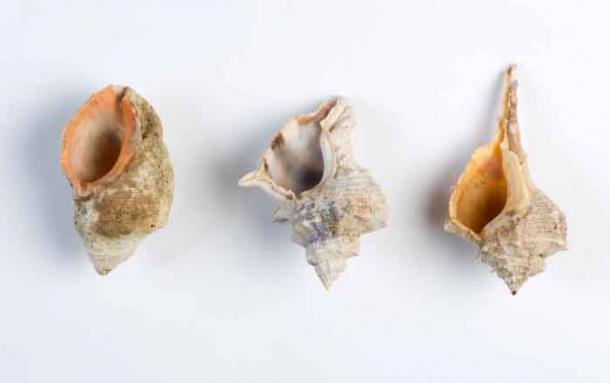Archaeologists Strike 3000-Year-Old “Royal Purple” In Israel Dig
Rare 3,000-year-old samples of “royal purple” have been discovered at Timna dating to the biblical reigns of King David and Solomon.
A team of researchers led by the Israel Antiquities Authority was exploring the ancient Timna Valley in southern Israel’s Negev, a region known for its ancient copper production, when they discovered a bundle of ancient, colored textiles. Among the cloths was a singular woven fabric, a tassel, and fibers of wool dating from approximately 1000 BC. And these three unique fabric samples were all dyed the legendary “royal purple”.

Wool fibers dyed with Royal Purple,~1000 BC, Timna Valley, Israel. (Dafna Gazit, courtesy of the Israel Antiquities Authority)
Biblical Blue Notes, Bordering On Purple
Putting the find in context, the light-purple dyed Iron Age textiles were spun in the same period of time associated with the biblical David and Solomon in Jerusalem, around 3,000-years-ago.
The dye, “royal purple,” which was a reserve of social elites, was produced from mollusks found in the Mediterraneanover 300 kilometers (186 miles) from Timna, which itself was a region mentioned several times in the Bible, both in Christian and Jewish contexts. Evidence of a purple dye factory has been found near Haifa further north, however, this is the first time that textiles dyed with the royal purple color have been found in Israel or the Southern Levant.
- Tunisian Man Rediscovers Secret of Priceless Ancient Purple Dye
- 3,000-Year-Old Phoenician Shell-Dye Factory Linked With The Temple
- Only the Roman Elite Could Wear Tyrian Purple to Keep the Peasants in Their Place

Wool textile fragment decorated by threads dyed with Royal Purple, ~1000 BC, Timna Valley, Israel. (Dafna Gazit, courtesy of the Israel Antiquities Authority)
The Timna Valley in southern Israel, in the southwestern Arava/Arabah, is located approximately 30 kilometers (19 miles) north of the Gulf of Aqaba and the city of Eilat and since the 5th millennium BC the area had been mined for copper ore. This new research project was led by professors Naama Sukenik and Orit Shamir from the Israel Antiquities Authority, Prof. Erez Ben-Yosef from the Jacob M. Alkow Department of Archaeology and Ancient Near Eastern Cultures at Tel Aviv University, in collaboration with Prof. Zohar Amar, Dr. David Iluz and Dr. Alexander Varvak from Bar-Ilan University.

Excavating Slaves' Hill. (Sagi Bornstein, courtesy of the Central Timna Valley Project)
Royal Purple: The King Of Iron Age Bling
Dr Ben-Yosef’s team has been excavating in the Timna Valley since 2013. Most recently they excavated “Slaves Hill,” the largest copper-smelting site in the Timna valley. Folded within three, 3,000-years-old, scraps of colored cloth, the team discovered the ancient sample of royal purple.
The ancient purple color known as “argaman” was a status symbol in the southern Levant. The team of researchers say that “For the first time” rare evidence has been found of fabric dyed with royal purple dating from the time of King David and King Solomon. However, according to a new paper published in the journal PLOS ONE, Jesus also wore the royal purple color.
Dr Sukenik explained to The Jerusalem Post that this is the first time the royal purple color has been found on textiles dating as far back as the Iron Age, around 3,000-years-ago. Furthermore, she said the discovery determines the residence at the ancient settlement of Timna were “upper class elites” as royal purple was the favored color of the noble classes. The primary reason for this was because the extraction of the light purple color from Mediterranean mollusks was an “expensive process,” added Dr Sukenik.

Shells of the three species of murex snails. Left to Right: S. haemastoma, H. trunculus and B. brandaris (Photo by Shahar Cohen / PLOS ONE).
Treading Water In Deep Purple Obscurity
Over the course of several years the team of researchers performed hundreds of attempts at recreating the ancient extraction procedures to obtain the royal purple color. The paper says that as part of their experimentation they cracked the shells of three species of mollusks, “to remove the raw material from the dye glands.” The scientists smashed: “Banded Dye-Murex” (Hexaplex trunculus), the “Spiny Dye-Murex” (Bolinus brandaris) and the “Red-Mouthed Rock-Shell” (Stramonita haemastoma).
Dr Amar, who was in charge of this smashing part of the project, said the entire process took the team back “thousands of years.” The researchers effectively compressed a process that took thousands of years of developing the in the field, into less than a decade, and while they never revealed all of the secrets of making the highly sought-after royal purple, they wrote in their paper that they “gained a better understand of the obscure historical sources associated with the precious colors of azure and purple”.
Top image: Wool textile fragment decorated by threads dyed with Royal Purple, ~1000 BC, Timna Valley, Israel. Source: Dafna Gazit, courtesy of the Israel Antiquities Authority
By Ashley Cowie




















Comments
Hi All,
Since archeologist are invested in that area now would be a good time to brush up on one's knowledge of The Tribe of Judah which David, Solomon, an let's not forget Jesus who was of The Line of David hence the reason for Bethlehem.
Exciting discovery found hope to learn more.
Next time, Everyone, Goodbye!
We’re getting closer to Kings David and Solomon.